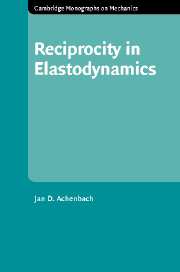Book contents
- Frontmatter
- Contents
- Preface
- 1 Introduction
- 2 Some elastodynamic theory
- 3 Wave motion in an unbounded elastic solid
- 4 Reciprocity in acoustics
- 5 Reciprocity in one-dimensional elastodynamics
- 6 Reciprocity in two- and three-dimensional elastodynamics
- 7 Wave motion guided by a carrier wave
- 8 Computation of surface waves by reciprocity considerations
- 9 Reciprocity considerations for an elastic layer
- 10 Forced motion of an elastic layer
- 11 Integral representations and integral equations
- 12 Scattering in waveguides and bounded bodies
- 13 Reciprocity for coupled acousto-elastic systems
- 14 Reciprocity for piezoelectric systems
- References
- Index of cited names
- Subject index
8 - Computation of surface waves by reciprocity considerations
Published online by Cambridge University Press: 10 December 2009
- Frontmatter
- Contents
- Preface
- 1 Introduction
- 2 Some elastodynamic theory
- 3 Wave motion in an unbounded elastic solid
- 4 Reciprocity in acoustics
- 5 Reciprocity in one-dimensional elastodynamics
- 6 Reciprocity in two- and three-dimensional elastodynamics
- 7 Wave motion guided by a carrier wave
- 8 Computation of surface waves by reciprocity considerations
- 9 Reciprocity considerations for an elastic layer
- 10 Forced motion of an elastic layer
- 11 Integral representations and integral equations
- 12 Scattering in waveguides and bounded bodies
- 13 Reciprocity for coupled acousto-elastic systems
- 14 Reciprocity for piezoelectric systems
- References
- Index of cited names
- Subject index
Summary
Introduction
It is shown in this chapter that the reciprocity theorem can be used to calculate in a convenient manner, that is, without the use of integral transform techniques, the surface-wave motion generated by a time-harmonic line load or a time-harmonic point load applied in an arbitrary direction in the interior of a half-space. The virtual wave motion that is used in the reciprocity relation is also a surface wave. Hence the calculation does not include the body waves generated by the loads. For a point load applied normally to the surface of a half-space, it is shown in Section 8.6 that the surface-wave motion is the same as obtained in the conventional manner by the integral transform approach.
It is well known that the dynamic response to a time-harmonic point load normal to the surface of the half-space was solved by Lamb (1904), who also gave explicit expressions for the generated surface-wave motion. The surfacewave motion can be obtained as the contribution from the pole in inverse integral transform representations of the displacement components. The analogous transient time-domain problem for a point load normal to the surface of the half-space was solved by Pekeris (1955). The displacements generated by a transient tangential point load applied to the half-space surface were worked out by Chao (1960).
- Type
- Chapter
- Information
- Reciprocity in Elastodynamics , pp. 132 - 144Publisher: Cambridge University PressPrint publication year: 2004

